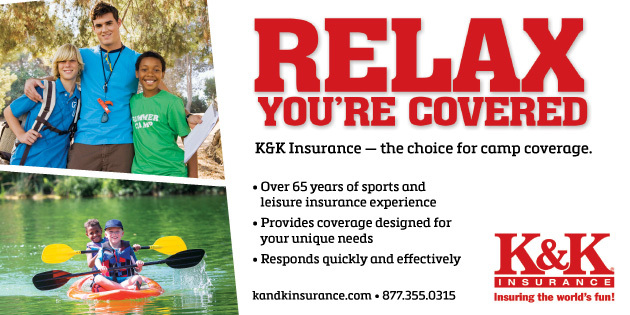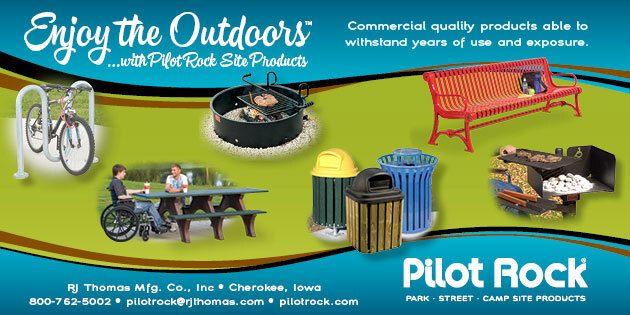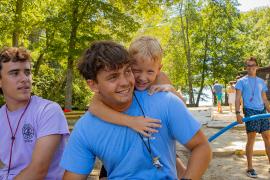Two summers ago, I led a staff training workshop with 180 camp staff from Blue Star Camps in Hendersonville, North Carolina. They had recently spent around $30,000 to replace their lights with more energy-efficient LED bulbs and fixtures. But while these kinds of upgrades can make a huge impact on reducing energy consumption, camp leaders found that the lights were being left on in unoccupied buildings.
Camp staff are the front line for setting expectations and modeling the behaviors they’d like to see from their campers. So, I brought the staff together to find solutions that would encourage campers and staff to turn lights off when leaving a room.
I started the workshop with a game to highlight the impact our actions have on others. The game we played was called “Equidistance” and was easy to set up and a lot of fun. Here’s how to run it: Have each staff member (or camper) secretly choose two people in the group. Explain that when the game starts, they are to place themselves an equal distance between their two choices. This could be in a straight line or a triangle. Start the activity. Can you guess what happens next? Give it a try with other staff members and consider how this activity can promote discussion around how our actions influence others.
After the workshop, a staff member asked me if turning the lights off would really make an impact on the bigger picture of what needs to be done to reduce our environmental impact. “Don’t we need larger systemic change to really have a global impact on environmental issues? How can my actions really have a meaningful impact on an issue that is so much bigger than any of us individually?” My answer was that to create systemic change, we need a collective voice to advocate for a world that makes sustainable living more accessible for everyone.
As a camp staff member, you can model green behaviors to demonstrate how accessible sustainability really is. You were hired because of your ability to be a role model for your campers and facilitate growth through the camp experience. Regardless of your prior knowledge of sustainability, you can take many simple actions to model and inspire green behavior change in your campers.
It’s easy to get overwhelmed trying to implement green actions that reduce water consumption, increase energy efficiency, or divert waste from the landfill. My advice is to keep it simple. I love that Blue Star Camps had a very specific and measurable goal of getting campers and staff to turn off the lights that summer. Choose an action that all of camp can get behind, and begin to build a culture of sustainability that will continue to grow year after year.
You might start by asking your campers what they know about sustainability. Many schools have gardens, compost systems, and other education programs that teach their students how to be better stewards of the environment.
As you read the following examples, facts, and resources, consider which of the behaviors you already practice and which you’d like to try this summer with your campers.
Picking up Trash
As you walk around camp, one green behavior you can always be modeling is picking up trash.
Every year, eight million tons of garbage are added to our oceans, 80 percent of it from mainland waste. That’s like dumping more than 112,123 Boeing 737-ER900 airplanes into the ocean each year.
Consider implementing a 10-pieces-of trash-a-day initiative for your cabin. If you have 10 campers in your cabin, that’s 100 pieces of trash every day! Picking up trash helps keep your camp beautiful and keeps trash from entering waterways and eventually finding its way to the ocean.
Thrift Store Shopping
The environmental impact of the clothing industry is staggering. Check out a few facts:
- Americans alone throw away about 10.5 million tons of clothing every year (Cline, 2014).
- The pair of jeans you may be wearing right now took roughly 1,800 gallons of water to make (Leon, 2019).
- Almost 20 percent of pesticide use worldwide is for use on cotton plants (Leon, 2019).
Yikes! This doesn’t mean we shouldn’t enjoy looking nice in our sweet threads, but you can do a lot to reduce the impact of your choices. Like buying organic cotton, sewing patches on warn areas of clothes, or shopping at a thrift store.
One of my favorite games to play with campers is called, “Guess what I’m wearing that came from a thrift store.” It’s a fun way to open a dialogue about a simple action we can take while also showing off your favorite thrift store finds.
Turn out the Lights
There’s no need to leave lights on in unoccupied buildings, and during the day you probably don’t even need to turn them on if there’s enough natural light.
Many camps have a clean cabin award to encourage campers to keep their cabins clean throughout the session. On my clean cabin inspection sheet, we had a spot to make note of lights left on, which would result in losing valuable points toward winning the clean cabin award that day.
You can also use signs to encourage campers to turn off the lights or practice other green behaviors. In my opinion, signage is one of the most powerful education tools.
In a workshop I facilitated with a group of Girl Scouts, I asked them to make signs that would encourage a green behavior that was important to them. I gave them some ideas like using quotes, drawing pictures, or cutting images out of magazines. The signs they came up with were very creative and gave them an opportunity to express themselves. The more you can involve campers in the process, the more buy-in they will have in supporting the action.
Turn off the Water When You Brush Your Teeth
It’s estimated that each person uses between 80 and 100 gallons of water each day. If you have 10 campers in your cabin, that could be up to 1,000 gallons of water a day!
Water is a valuable resource, and so much of it runs down the drain every day. Turning off the water while you brush your teeth can save up to four gallons. We often take water and other resources we use every day for granted. Being able to quantify those resources can go a long way in helping campers understand the impact of reducing our consumption.
Here’s a fun way to help your campers quantify the amount of water they use when showering or running a faucet.
Grab a timer and a gallon jug and take your campers into a shower stall to time how long it takes to fill the jug with water. To determine the flow rate (gallons/minute), divide one (number of gallons) by the time it takes to fill the jug (minutes). You can then multiply the total shower time by the flow rate to determine how many gallons each shower uses. Ask your campers how long their showers are on average at home. Use that number to calculate how much water they use when showering.
Many camps have a five-minute shower policy. I’m sure this is partially to save water, but also to help get a bunch of campers showered efficiently. Whatever the reason, your campers might be more cooperative if they understand how much water is being used to take a shower.
Remember the importance of modeling behavior as a staff member. If you’re going to ask campers to take a five-minute shower or turn off the water when brushing their teeth, you should adhere to the same expectations you’re asking of them.
Clean Plate Club
Food is a valuable resource, and it takes a lot of energy to produce what we eat. Produce from the local grocery store travels on average 1,500 miles from the farm to your plate (Black, 2008). Consider everything that goes into growing, harvesting, packaging, and transporting each item of food you consume. A fun thought activity is to brainstorm every step of this journey with an item of food.
The clean plate club encourages campers to reduce the amount of food left on their plates. The goal is to ask campers to only take what they can eat and eat what they take. They can always go back for more, but sometimes our eyes are bigger than our stomachs, which leads kids to waste. Like anything at camp, if you express enthusiasm, your campers will likely be into it too.
Water Bottles and Mugs
Do you have a favorite water bottle or travel coffee mug? The behavior of using your own liquid-consuming vessel makes a big impact on reducing waste. How many cups of coffee/tea do you have each day? Week? Month? Year?
It’s estimated that 50 billion paper coffee cups are being thrown away in the United States every day. What would it take to get more people to stop using paper cups? You can start by making your coffee mug and/or water bottle a fixture in your daily life.
My coffee mug and water bottle are covered in cool stickers that I’ve collected from my travels, along with cool logos from companies I support like Patagonia and Green Camps. You can also use the stickers as a great conversation starter. “Pick a sticker and I’ll tell you about why I chose to put it on my water bottle.”
Sustainability is a broad and often overwhelming subject, so it’s important to take small, practical steps to build the culture of sustainability at your camp. My challenge to you is to start a conversation and invite campers to participate in supporting conservation efforts while at camp. Your influence can also span beyond camp when campers return home with new green behaviors to share with their families and friends.
Your actions, even the small ones, can make a huge difference in the health of our one and only planet. Remember that you aren’t alone. I encourage you to start a green team to model sustainability if your camp doesn’t already have one. As a team, each member brings experiences, ideas, and energy to take small steps that can lead to huge results. Your camp leadership may also have other resources and ideas to support your efforts.
Building buy-in and a culture of sustainability at any organization is a challenging and sometimes long journey. That’s why modeling green behavior is a great place to start. Doing so is relatively easy, and these actions can have far-reaching consequences. Over time, as campers return year after year, it will become habit to pick up trash, waste less food, put recyclables in the right place, and turn off the water when they brush their teeth.
Please consider the following notes before you dive headfirst into helping your camp model sustainability.
Don’t Shame Anyone, Including Yourself and Your Camp
It’s easy to look around and see things that are “not environmentally friendly,” both at your camp facility and in the behaviors of other staff and campers. Shaming someone for wasting food or not turning off the lights isn’t going to inspire anyone to change their behaviors. Instead, focus on the positive things you and your camp are already doing. You should also focus on solutions instead of dwelling on the problems.
Create a Green Proposal
Camp program staff and directors have a lot of responsibilities to ensure camp is running smoothly and safely and that campers are having fun. Create a proposal that outlines your ideas and answers questions or challenges that will inevitably come up should they try to make the idea a reality. Consider the following questions to include in your proposal:
- How did you come up with the idea?
- How will your idea benefit the campers, staff, and facility?
- Who needs to be involved to make the idea happen?
- How much will it cost?
- What resources will be needed to make this happen?
- How will this idea continue at camp in the future?
Join the Conversation
I hope you see the opportunity for the camp community to lead the nation in modeling sustainability and inspiring green behavior change. It’s no easy task, but as camps around the country begin to take action and see the benefits, the sustainable camps movement will continue to grow.
Together we can work to find practical and engaging experiences to inspire green behavior change in the millions of youth and adults the camp experience impacts each year.
Join the conversation to share your successes and challenges, learn from other camps, and find answers to support your efforts: #gogreencamps.
Discussion Questions
- What does “being green” mean to you?
- What does “quality of life” really mean? Would a sustainable lifestyle affect our quality of life? What might you be able to give up without jeopardizing your quality of life?
- What, in your opinion, is the biggest obstacle to a move toward sustainability, and how might modeling sustainability at camp help overcome that obstacle?
- What green pledge would you be willing to make for the summer to inspire green behavior change in your campers and fellow staff members?
References
- Black, J. (2008, September 17). What’s in a number? Slate. Retrieved from slate.com/human-interest/2008/09/how-the-press-got-the-idea-that-food-travels-1500-miles-from-farm-to-plate.html
- Cline, E. (2014, July 18). Where does discarded clothing go? The Atlantic. Retrieved from theatlantic.com/business/archive/2014/07/where-does-discarded-clothing-go/374613/
- Leon, L. (2019, March 12). Why thrifting is good for the planet, not just your wallet. Student Environmental Resource Center, University of California Berkeley. Retrieved from serc.berkeley.edu/why-thrifting-is-good-for-the-planet-not-just-your-wallet/
Danny Sudman is the founder and executive director of Green Camps. Growing up, Danny spent 16 summers at YMCA Camp Hanes in North Carolina, first as a camper and later as a camp counselor. After receiving his BA in Sociology from North Carolina State University, he went on to join the leadership team at Catalina Island Camps where he managed the challenge course program and served as an environmental educator. While on the island, he completed the Catalina Environmental Leadership Program, an initiative of Jean Michel Cousteau’s Ocean Futures Society. Danny founded Green Camps in 2014, believing 100 percent in the extraordinary ability of camp to inspire the next generation of eco-leaders. Danny is an active member of the American Camp Association and the Association of Environmental and Outdoor Educators. His service to the camp community was recognized in 2011 with the Rising Star Award and in 2014 with the Paul Somers Golden Acorn.




